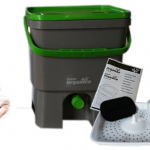What is Bokashi and why is it recommended to make Bokashi yourself?
Bokashi loosely translated means “all sorts of things" and is a Japanese term for fermented, organic materials. Unlike compost, the fermentation (formerly called “fermentation") occurs in the absence of air, also called anaerobic.
The microorganisms in bokashi use sugars in the uncooked kitchen waste and multiply. They lower the pH and negative microorganisms are displaced. Existing nutrients are broken down and supplemented by the natural metabolic products of the microorganisms – nothing is lost, in fact, more is added. We know this principle, for example, from the production of sauerkraut. Bokashi is an ecological fertilizer made from fermented organic waste residues, which are mainly produced in our everyday life in our kitchen. So it ferments the leftovers that would otherwise be thrown away. Bokashi is easy to make and requires only a few aspects to be taken into account to support the fermentation process. Bokashi is suitable for any garden, balcony or patio where the soil and plants need to be supported with high quality and organic fertilizers.
Bokashi offers several advantages over other coventional but also ecological fertilizers:
During the fermentation of Bokashi, microorganisms release enzymes, antioxidants and vitamins (similar to the production of sauerkraut).
Rapid availability of nutrients to plants
Soil life is promoted, which leads to the soil being loosened and its structure improved;
it becomes more receptive to nutrients and water;
gas exchange is also promoted (oxygen/carbon dioxide)
Targeted humus build-up
Bokashi serves as food for soil organisms
no odor nuisance due to non-occurring “rotting of the organic waste
Bokashi is a sensible utilization of kitchen waste in several respects. Recycling your own green waste is not only ecological, but also fun – especially when you see how well the plants develop.
Which plant materials do I use for my Bokashi?
All plant materials are basically suitable. For example, leftovers from food preparation such as potato, beet or onion peelings, lettuce leaves, cabbage stalks, leek roots, fruit waste, etc. Cooked food scraps, coffee grounds, tea leaves, bread crumbs, rice wash water, etc. are also suitable. Nevertheless, one should be careful with cooked food leftovers, especially if additives have also been used. Meat has no place in Bokashi for hygienic reasons.
What do I need for Bokashi production and how do I apply it in general?
The production of Bokashi can basically work with all containers that limit the oxygen supply and thus promote the fermentation process. It is important to empty the container of the liquids (leachate) produced over the days, so as not to encourage rotting processes.
With a special Bokashi bucket you can easily store your organic waste in the kitchen without using bags or having to empty the bucket used for fermentation every day because of the liquid produced. In this special container, the Bokashi kitchen bucket, you can turn your kitchen waste into valuable fertilizer already in the kitchen. The Bokashi kitchen bucket has an air-sealing lid. Thus, the organic waste is fermented and there are no annoying odors in the kitchen. Depending on the temperature profile in the Bokashi kitchen bucket, the biowaste is fermented after about two to three weeks and can be spread as a valuable soil improver and fertilizer on the garden beds, in the balcony boxes or patio pots mixed with soil in a ratio of 1:1. Additional benefits: Fermentation produces an equally useful organic leachate that you can add directly to irrigation water mixed 1:100 with water.



